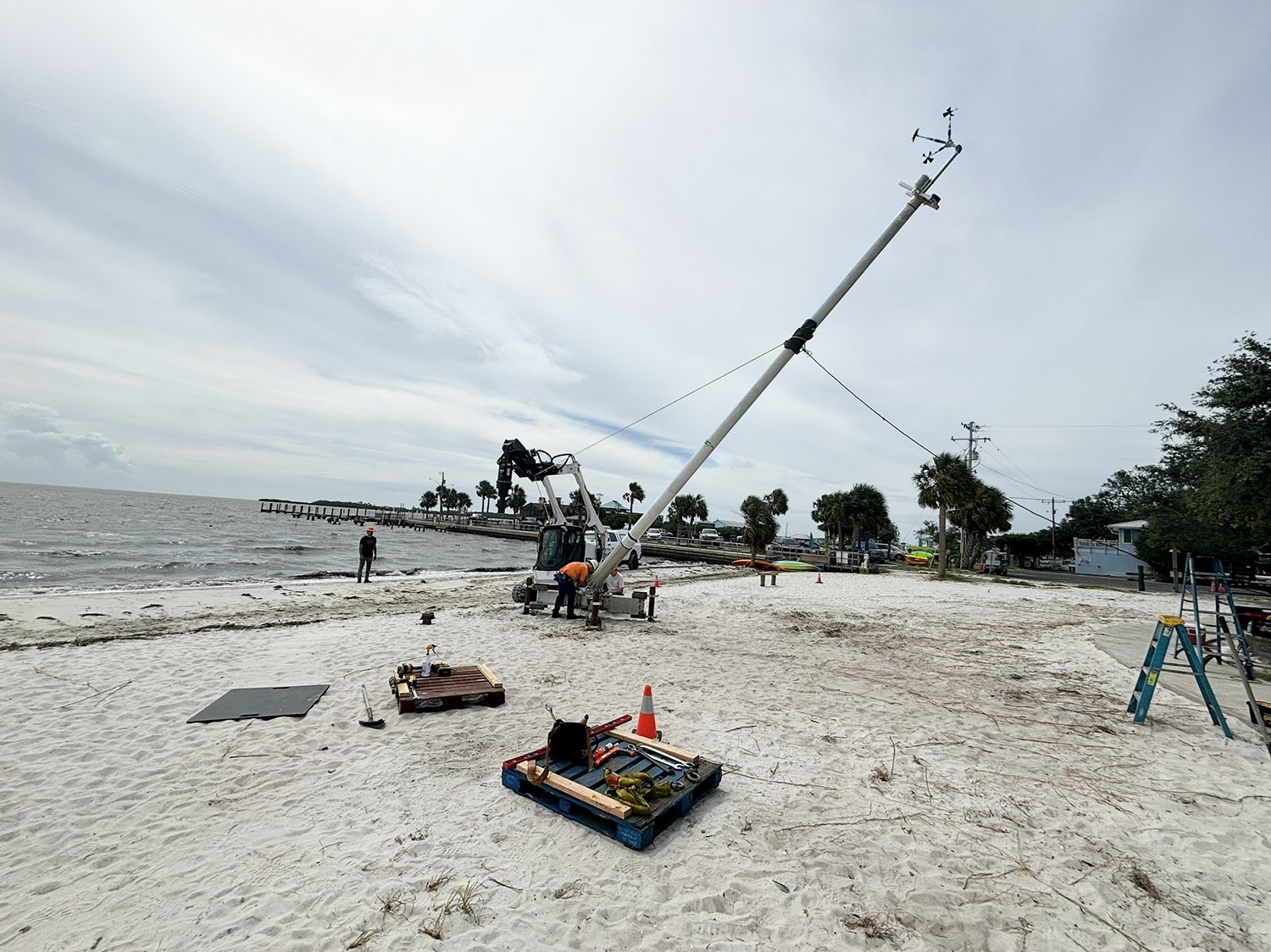FOR IMMEDIATE RELEASE
Hurricane Helene: NSF-Funded Natural Hazards Experts Ready for Comment

Before Hurricane Helene made landfall, the University of Florida-led team installed the Sentinel mobile weather station at Cedar Key Beach, in Florida's Big Bend region. The Sentinel, which stands 33 feet tall, collects data on wind, storm surge, waves and water quality. This was the Sentinel's first deployment. (Image: Dave Schlenker, UF)
OCTOBER 3, 2024. WEST LAFAYETTE, IN. — Experts from the NSF-supported Natural Hazards Engineering Research Infrastructure (NHERI) are available to discuss issues related to Hurricane Helene.
NHERI researchers are authorities in infrastructure damage from wind and storm surge, damage mitigation efforts, post-event data collection, and societal impacts in hurricane-prone regions.
Storm damage to buildings and construction materials
Arindam Chowdhury is principal investigator for the NSF NHERI Wall of Wind laboratory, located at Florida international University in Miami. A wind engineer, Chowdhury tests the effect of hurricane-force winds and rain on buildings and construction materials at the Wall of Wind, a wind-tunnel facility where full-scale houses can be tested in with wind speeds up to 157 MPH, in conditions that closely resemble those of a Category 4 hurricane. Chowdhury also directs the Wind Engineering Research lab at Florida International University.
Email: Arindam.Chowdhury@fiu.edu
Phone: 305-348-0518
Field experiments in landfalling hurricanes
Brian Philips, University of Florida, is principal investigator for the NSF-funded Sentinel project. Phillips and his team installed the first ever Sentinel mobile weather station at Cedar Key Beach (Big Bend area) prior to Hurricane Helene landfall. This weather station collected data on wind, storm surge, waves and water quality. Phillips has expertise in mobile data collection, structural dynamics, experimental methods, optimization, protective systems, wind engineering, and earthquake engineering.
Email: brian.phillips@essie.ufl.edu
Forrest Masters is based at University of Florida. During hurricane season, he heads into hurricane landfall zones and sets up live experiments to collect data on damaging winds, wind-driven rain and structural loading. In the laboratory, Masters conducts research on full-scale building systems subjected to realistic simulations of fluctuating wind load and rain conditions to evaluate their performance.
Email: masters@eng.ufl.edu
Phone: (352) 392-6000
Instrumentation for post-hurricane data collection
Joe Wartman is principal investigator for the NSF NHERI Natural Hazards reconnaissance facility, also known as the RAPID. Based at the University of Washington, the RAPID facility provides investigators with equipment, software and support services needed to collect, process and analyze perishable data from natural hazard events, including hurricanes, windstorms, and floods. For Hurricane Helene, the RAPID did a major pre-deployment in support of NEER; the RAPID Z-boat has deployed to Florida for post-event reconnaissance.
Email: uwrapid@uw.edu
Phone: (206) 616-3318
Storm surge and wave impact on coastal communities
Nina Stark is faculty lead in University of Florida’s coastal and marine geotechnics research group and an active field researcher. Prior to Hurricane Helene’s landfall, she led the UF’s Nearshore Extreme Events Reconnaissance group, NEER, that deployed dozens of sensors along Florida’s Big Bend coastline; after the storm, she also led the first scouts into the damaged areas for Florida Building Code officials. Stark has co-led GEER reconnaissance missions in response to Harvey and Irma in 2017, the Western European floods in 2021, and the Yellowstone Flood in 2023. She also participated in data collection for Idalia in 2023.
Email: nina.stark@essie.ufl.edu
X: @NinaStark18
Daniel Cox is principal investigator for the NSF NHERI at OH Hinsdale Wave Research Laboratory, located at Oregon State University. Cox uses physical and numerical models to study the effects of surge and wave damage to coastal communities. He studies wave impact on prototype scale building components, debris, sediment scour and erosion, and he also explores how natural systems, such as mangroves and dunes, can be engineered to mitigate the effects of coastal surge and waves.
Email: dan.cox@oregonstate.edu
Phone: (541) 737-3631
Clint Dawson is based at University of Texas, Austin, where he models and simulates the coastal ocean with applications in hurricane storm surge, tsunamis, and environmental hazards such as oil spills. Using ADCIRC, He runs forecast models while hurricanes are approaching land, and he performs forensic studies to quantify the impacts of coastal disasters. He utilizes high-performance computing methods, big data, and scientific computing algorithms.
Email: clint@ices.utexas.edu
Phone: 512-475-8627
Reconnaissance for post-hurricane data collection
Lori Peek is principal investigator for the NHERI CONVERGE facility at the University of Colorado Boulder, which coordinates NHERI's interdisciplinary extreme events research (EER) teams. ethical, multi-disciplinary efforts in post-disaster reconnaissance. Before and after hurricanes, trained reconnaissance teams work virtually and in the field to collect perishable data about hazard characteristics, physical damage and the social disruptions caused by natural hazards.
Email: lori.peek@colorado.edu
Phone: (303) 492-9061
NHERI Recon teams Responding to Helene
Before and after hurricanes, NHERI's trained EER teams work virtually and in the field to collect perishable data about hazard characteristics, physical damage and the social disruptions caused by natural hazards.
Nearshore Extreme Events Reconnaissance, NEER NetworkHurricane coastal impacts Britt Raubenheimer, NEER principal investigator, Woods Hole Oceanographic Institute |
Geotechnical Extreme Events Reconnaissance, GEER AssociationGeotechnical and inland flooding David Frost, principal investigator, Georgia Tech |
Structural Extreme Events Reconnaissance, StEER NetworkImpacts on the built environment Tracy Kijewski-Correa, StEER director, Notre Dame University |
Public Health Extreme Event Research, PHEER NetworkEstablishing a location-based data operations group that can rapidly carry out geospatial analyses of Helene’s impacts, including aggregate cell phone data, social media data, Point of Interest (POI) data, and satellite data. PHEER principal investigators: David Abramson, New York University Jennifer Horney, University of Delaware David Eisenman, UCLA Nicole Errett, University of Washington |
More News
Fellow researchers and the general public are welcome to join NHERI discussion boards on Slack. Users must first create an account on the DesignSafe Cyberinfrastructure.





